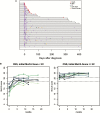A Multicenter, Longitudinal Cohort Study of Cryptococcosis in Human Immunodeficiency Virus-negative People in the United States
- PMID: 30855688
- PMCID: PMC6938979
- DOI: 10.1093/cid/ciz193
A Multicenter, Longitudinal Cohort Study of Cryptococcosis in Human Immunodeficiency Virus-negative People in the United States
Abstract
Background: Cryptococcosis is increasingly recognized in people without human immunodeficiency virus (HIV).
Methods: A multicenter, prospective cohort study was performed in 25 US centers. Consenting patients were prospectively followed for ≤2 years. Neurological morbidities were assessed with longitudinal event depiction and functional scores (Montreal Cognitive Assessment [MoCA]). Risks of death were analyzed using Cox regression.
Results: One hundred forty-five subjects were enrolled. Most were male (95; 65.5%) and had immunosuppression (120; 82.8%), including solid organ transplant (SOT; 33.8%), autoimmunity (15.9%), and hematologic malignancies (11.7%). Disease involved the central nervous system (CNS) in 71 subjects (49%). Fever was uncommon, documented in 40 (27.8%) subjects, and absence was associated with diagnostic delay (mean: 48.2 vs 16.5 days; P = .007). Abnormal MoCA scores (<26) were predictive of CNS disease; low scores (<22) were associated with poor long-term cognition. Longitudinal event depiction demonstrated frequent complications in people with CNS disease; 25 subjects (35.2%) required >1 lumbar puncture and 8 (11.3%) required ventriculostomies. In multivariable models, older age (>60 years) was associated with higher risks of death (hazard ratio [HR], 2.14; 95% confidence interval [CI], 1.05-4.38; P = .036), and lower risks were noted with underlying hematologic malignancy (HR, 0.29; 95% CI, 0.09-0.98; P = .05) and prior SOT (HR, 0.153; 95% CI, 0.05-0.44; P = .001).
Conclusions: Despite aggressive antifungal therapies, outcomes of CNS cryptococcosis in people without HIV are characterized by substantial long-term neurological sequelae. Studies are needed to understand mechanism(s) of cognitive decline and to enable better treatment algorithms.
Keywords: cryptococcosis; cryptococcus; outcomes; transplant.
© The Author(s) 2019. Published by Oxford University Press for the Infectious Diseases Society of America. All rights reserved. For permissions, e-mail: journals.permissions@oup.com.
Figures





Comment in
-
A Multicenter, Longitudinal Cohort Study of Cryptococcosis in Human Immunodeficiency Virus-Negative People in the United States.Clin Infect Dis. 2020 Dec 31;71(11):3014-3015. doi: 10.1093/cid/ciaa296. Clin Infect Dis. 2020. PMID: 32188972 No abstract available.
-
Reply to Pan et al.Clin Infect Dis. 2020 Dec 31;71(11):3015. doi: 10.1093/cid/ciaa297. Clin Infect Dis. 2020. PMID: 32188984 Free PMC article. No abstract available.
References
-
- Park BJ, Wannemuehler KA, Marston BJ, Govender N, Pappas PG, Chiller TM. Estimation of the current global burden of cryptococcal meningitis among persons living with HIV/AIDS. AIDS 2009; 23:525–30. - PubMed
-
- Davis JA, Horn DL, Marr KA, Fishman JA. Central nervous system involvement in cryptococcal infection in individuals after solid organ transplantation or with AIDS. Transpl Infect Dis 2009; 11:432–7. - PubMed

